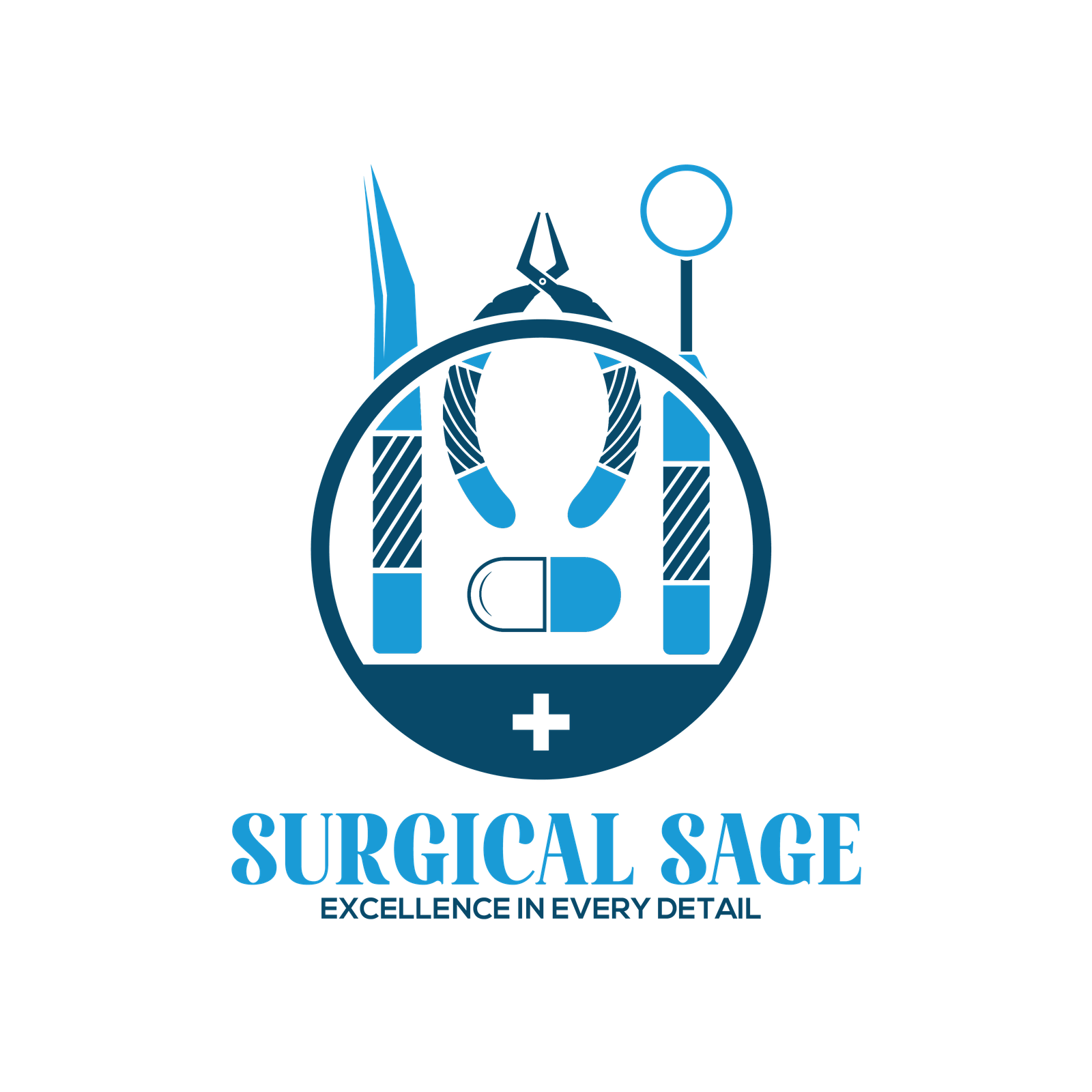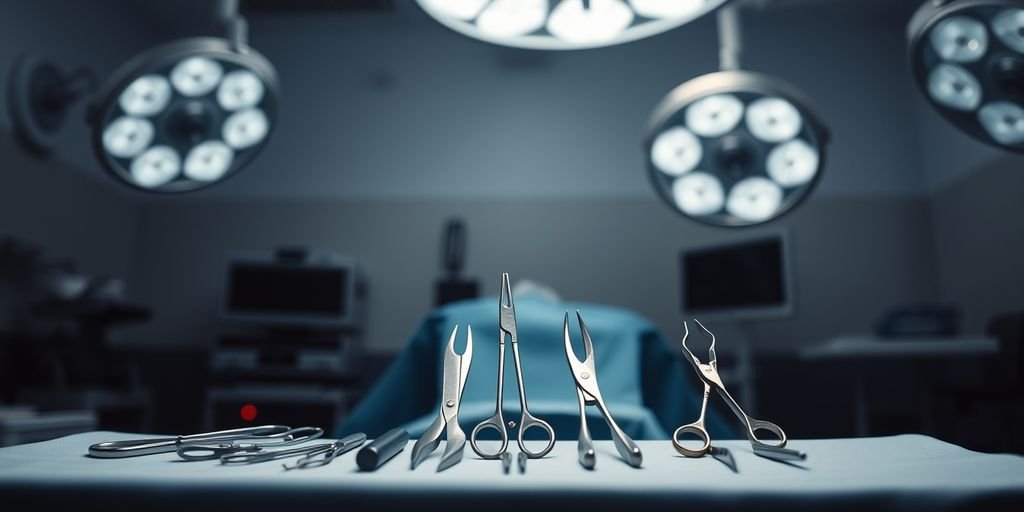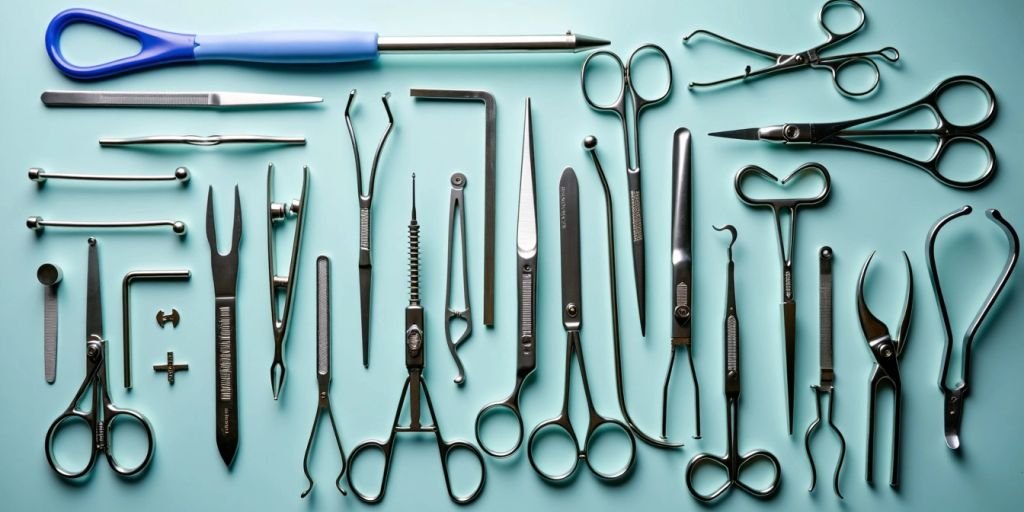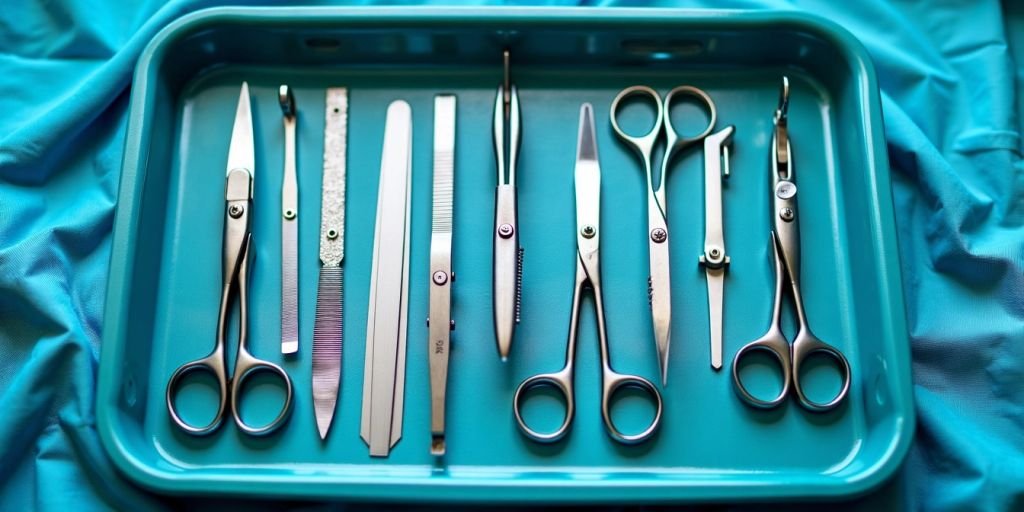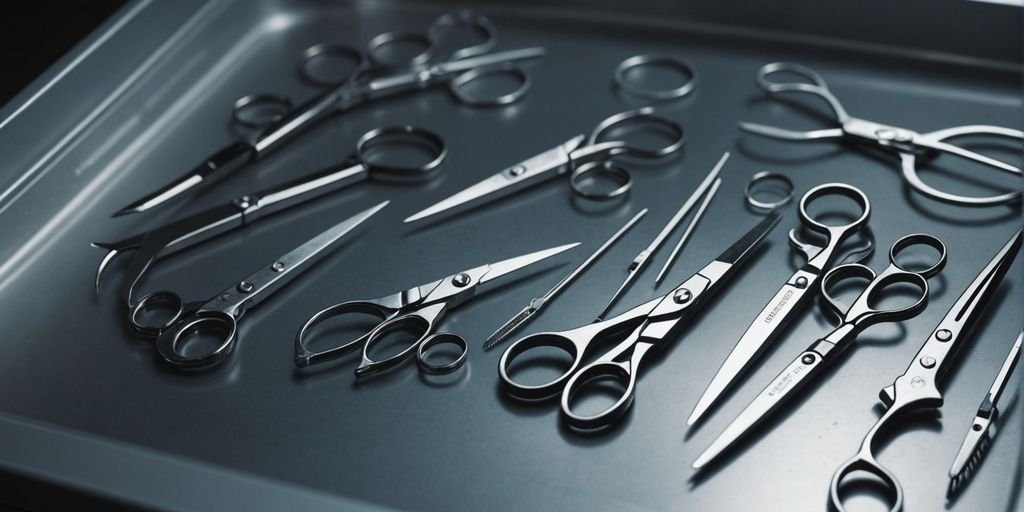Surgical instruments are the backbone of any successful operation. They allow surgeons to perform precise and complex procedures, ensuring the best possible outcomes for patients. In this article, we’ll explore the top 10 essential surgical instruments that every operating room must have.
Key Takeaways
- Scalpels are used for making precise cuts and incisions.
- Forceps help in grasping and holding tissues during surgery.
- Retractors are essential for holding open incisions and providing access to the surgical area.
- Scissors are used for cutting tissues, sutures, and other materials.
- Needle holders are crucial for holding and passing sutures through tissues.
Scalpel
A scalpel is a small, sharp knife used in surgeries. It is one of the most important tools in an operating room. Surgeons use scalpels to make the first cut, create openings, and perform delicate dissections.
Scalpels come in two parts: a handle and a blade. The blades can be different shapes and sizes to meet various surgical needs. The three most common blades are:
- 10-blade: Used for larger soft tissue incisions.
- 11-blade: Longer and pointier, used for stab-like incisions to open big vessels.
- 15-blade: Small and delicate, used for precise cuts.
Scalpels are essential for making the first incision and performing delicate dissections during surgeries.
Our catalog includes a variety of surgical blades, scalpels, handles, and other essential tools, all crafted with precision to support surgeons in delivering the best care.
Forceps
Forceps are essential tools in any operating room. They come in various shapes and sizes, each designed for specific tasks. These instruments are used to hold and manipulate tissues, sutures, and other materials during surgery. Here are some common types of forceps:
- Adson Bipolar Forceps: These are like tweezers made of stainless steel, designed to hold small or slippery tissues with precision.
- Adson Brown Forceps: With short jaws and narrow tips, these are used to pick up delicate tissue, often in cosmetic and ENT surgeries.
- Backbiting Forceps: These have a long, slanted neck for easy access into the nasal cavity, commonly used in sinus surgery.
- Babcock Forceps: Known for their loop blades, these are used to hold intestines and other tube-shaped structures without causing damage.
- Carmalt Forceps: Part of the hemostat family, these have grooves along the blades and cross-serrated tips for a good grip on heavy tissue.
Forceps are versatile and indispensable in surgical procedures, ensuring that tissues and other materials are handled with care and precision.
Retractor

Retractors are vital tools in surgery, designed to hold back tissues or organs, providing better access to the surgical field. Ultimately, retracting instruments enhance surgical precision and enable a more controlled surgical procedure by providing better visibility and access to the surgical site.
Types of Retractors
- Handheld Retractors: These are manually held to maintain tissue retraction during surgery. Examples include Richardson retractors and Army-Navy retractors.
- Self-Retaining Retractors: These have a ratcheting mechanism that keeps the blades in place without the need for continuous manual holding. Examples include Gelpi retractors and the Weitlaner retractor.
Specialized Retractors
- Rib Spreaders: Used in thoracic surgeries to gently separate the ribs, allowing access to the thoracic cavity. Common examples include sternal retractors and Finochietto retractors.
- Abdominal Retractors: Designed to offer access to the abdominal cavity during various procedures. Examples include Bookwalter retractors and Balfour retractors.
Retractors come in various shapes, sizes, and designs to suit different surgical requirements. They are an essential part of the 54 basic surgical instruments.
Scissors
Surgical scissors are precision cutting tools specifically designed for use in a variety of medical procedures, with a primary focus on surgical interventions. They are designed to cut through tissues, sutures, and other materials with precision and control. Surgical scissors come in a variety of shapes, sizes, and designs depending on the specific surgical task they are intended for.
These scissors typically have sharp, finely pointed blades made from high-quality stainless steel or other materials that are resistant to corrosion and can be sterilized easily. The blades may be straight or curved, depending on the intended use. Straight scissors are often used for cutting through tissues and sutures in straightforward access areas, while curved scissors are helpful for accessing and cutting tissues in hard-to-reach areas or during procedures where visibility is limited.
Surgical scissors are an essential tool in the operating room, and they are used by surgeons, nurses, and other medical professionals to perform precise cutting and dissecting tasks during surgical procedures.
Needle Holder
A needle holder is a crucial tool in any surgical setting. It is designed to hold the needle securely while suturing tissues. This instrument ensures precision and control, which is vital for successful surgical outcomes.
Types of Needle Holders
There are various types of needle holders, each suited for different surgical needs:
- Mayo Hegar Needle Holder: Known for its versatility, it is commonly used in general surgery. The Mayo Hegar Needle Holder is often 6 inches long and features tungsten carbide inserts for durability.
- Webster Needle Holder: Typically used in plastic surgery, it is designed to hold small needles and suture materials.
- Heaney Needle Holder: Often used in gynecological procedures, it has ratcheted blades for medium-weight suturing.
Features to Consider
When selecting a needle holder, consider the following features:
- Length: Choose a length that provides comfort and control for the specific procedure.
- Jaw Design: Smooth or serrated jaws can affect the grip on the needle.
- Material: Stainless steel is common for its durability and ease of sterilization.
A well-chosen needle holder can make a significant difference in the efficiency and success of a surgical procedure. Always select the right tool for the job to ensure the best outcomes.
Tissue Forceps
Tissue forceps are a must-have tool in any operating room. They are designed to handle tissues gently and precisely during surgery. These forceps come in various types, each suited for specific tasks.
Types of Tissue Forceps
- Debakey Forceps: These are non-toothed forceps used in many procedures. They are ideal for grasping tissues like the bowel without causing damage.
- Adson Forceps: These forceps have a toothed tip and are used for handling dense tissues, such as during skin closures.
- Bonney Forceps: Heavy-duty forceps used for holding thick tissues, like during fascial closure.
- Lane Tissue Forceps: These have interlocking teeth, making them perfect for grasping tough tissues like fascia.
- Littlewood Forceps: These have blunt-ended teeth and are often used to gain entry via the umbilicus for laparoscopic surgery.
- Sawtell Forceps: Curved forceps with a serrated end, often used to grasp vessels before ligation.
Elevate your surgical procedures with our high-quality tissue forceps at Cross Instruments. They are an essential tool for any medical professional.
Key Features
- Precision: Designed for accurate handling of tissues.
- Variety: Available in different types to suit various surgical needs.
- Safety: Made to minimize tissue damage during procedures.
Tissue forceps are indispensable in surgeries, ensuring that tissues are handled with care and precision. Make sure your operating room is equipped with the best tissue forceps to enhance surgical outcomes.
Trocar
A trocar is a vital surgical instrument used for draining fluid or creating access points during surgeries. It is especially important in laparoscopic procedures.
Uses of Trocar
- Draining fluid from body cavities
- Creating access points for other surgical instruments
- Inserting chest tubes during thoracic surgeries
Types of Trocars
- Disposable Trocars: Used once and then discarded to ensure sterility.
- Reusable Trocars: Can be sterilized and used multiple times.
- Thoracic Trocars: Specifically designed for inserting chest tubes.
The trocar is indispensable in modern surgery, providing a reliable method for creating access points and facilitating various procedures.
Key Features
- Sharp pointed end for easy insertion
- Cannula to maintain the opening
- Handle for better control
Important Considerations
- Always ensure the trocar is sterile before use.
- Choose the appropriate type based on the surgical procedure.
- Handle with care to avoid injury to surrounding tissues.
Bone Saw
A bone saw is a crucial tool in orthopedic and other types of surgeries. It is used to cut through bone with precision and efficiency. There are different types of bone saws, including manual and electric versions.
Types of Bone Saws
- Manual Bone Saw: This traditional tool requires physical effort to operate. It is often used in situations where electric power is not available.
- Electric Bone Saw: This modern tool, such as the electric bone cutting oscillating saw, enhances precision and efficiency. It often features attachments like a vacuum for better performance.
Uses of Bone Saw
- Orthopedic Surgery: Cutting through bones to correct deformities or injuries.
- Veterinary Surgery: Used in animal surgeries for precise bone cutting.
- Autopsies: Employed to examine bones during post-mortem examinations.
The bone saw is indispensable in surgeries requiring bone cutting, offering both precision and efficiency. Its various types cater to different surgical needs, making it a versatile tool in the operating room.
Rongeur
A rongeur is a powerful surgical tool used to remove small pieces of bone or soft tissue. These instruments are essential in various surgical procedures, including orthopedic, neurosurgical, and maxillofacial surgeries.
Key Features
- Sharp, cup-shaped tips: These allow surgeons to grasp and extract bone or tissue fragments effectively.
- Strong and durable: Made from stainless steel, rongeurs are built to withstand the rigors of surgery.
- Variety of sizes: Available in different sizes to suit various surgical needs.
Common Uses
Rongeurs are often used in procedures such as:
- Orthopedic surgeries: To remove bone spurs or fragments.
- Neurosurgeries: To access and remove parts of the skull or vertebrae.
- Maxillofacial surgeries: To reshape or remove bone in the facial area.
Rongeurs are also called bone biters or bone nibblers, as their main function is to cut or remove small pieces of tissue or bone.
Tips for Use
- Always ensure the rongeur is sterilized before use.
- Use a lap sponge to clean bone fragments off the tips during surgery.
- Handle with care to avoid damaging surrounding tissues.
Surgical Drill

A surgical drill is a vital tool in the operating room, especially for orthopedic procedures. It is used to drill holes in bones or other hard materials. These tools can include drills, saws, screwdrivers, and other devices designed for specific surgical tasks.
Uses
- Drilling holes in bones for screws or pins
- Creating openings for implants
- Assisting in the removal of bone fragments
Key Features
- Precision: Surgical drills are designed to provide high accuracy.
- Speed Control: They often come with adjustable speed settings to suit different tasks.
- Ergonomics: Designed for comfortable handling during long procedures.
Types
- Manual Drills: Operated by hand, used for simple tasks.
- Powered Drills: Electric or battery-operated, used for more complex procedures.
The surgical drill is indispensable in modern surgery, providing the precision and control needed for successful outcomes.
Conclusion
In conclusion, having the right surgical instruments is essential for any operating room. These tools not only help surgeons perform precise and effective procedures but also ensure patient safety and successful outcomes. From scalpels to retractors, each instrument plays a unique role in the surgical process. By equipping operating rooms with these essential tools, medical facilities can provide high-quality care and improve patient recovery times. Remember, the success of a surgery often depends on the quality and availability of these critical instruments.
Frequently Asked Questions
What is a scalpel used for in surgery?
A scalpel is a small, sharp knife used to make precise cuts or incisions during surgery.
How do forceps help during an operation?
Forceps are like tweezers that help doctors grasp, hold, and manipulate tissues during surgery.
What is the purpose of a retractor?
A retractor is used to hold incisions open, allowing surgeons to see and access the area they are working on.
Why are surgical scissors important?
Surgical scissors are used to cut tissues, sutures, and other materials during an operation.
What does a needle holder do?
A needle holder is a tool used to hold and guide a needle while stitching tissues together.
When is a trocar used in surgery?
A trocar is used to create access points for minimally invasive surgeries, allowing instruments to enter the body.
